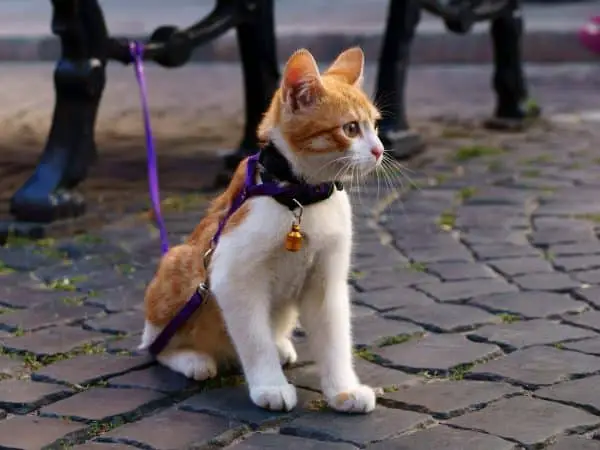A cat on a leash. It’s becoming more and more common. I think it’s a great thing for indoor cats personally, of course providing they are actually into it. A bonding experience venturing outside together …
Keep in mind it’s not only canines who enjoy this pursuit. In fact, some cats love it and get excited by the prospect of the leash just like dogs. Even more importantly, walking on a leash will give kitty many benefits that she will not enjoy otherwise…
Benefits of Walking a Cat on a Leash
We all know taking the dog out for a daily walk is crucial for his health, his wellbeing and the sense of bonding between you and your dog. But what about cats? Do they gain anything by donning the leash
Why, yes. Here’s a list of awesome benefits that taking your cat on outdoor leash excursions will have for your kitty…
- Your cat will get to enjoy the great outdoors, and be able to see all the little animals she so enjoys terrorizing (for example, squirrels, woodchucks, maybe even the occasional tasty little mouse). No, she won’t be able to eat them, but at least she can practice her big, ferocious tiger act!
- Your kitty will feel energized by the fresh air and new surroundings. We all like a break from the four walls, don’t we
- Your cat will get more exercise, which will be helpful if kitty has a bit of an expanding waistline!
- Your cat might have the opportunity to see and safely interact with other neighborhood cats.
- You will have additional bonding time with your kitty. And your cat will learn to trust and depend on you even more.
- Your cat will not face the dangers that would be present if she were outside without a leash (cars, dogs, other cats that might fight with her, and so on).
Warning: Not all cats like the leash
Yes, walking your cat on a leash has lots of benefits, but unfortunately not all cats are appreciative of this activity. There are some cats that will flat out refuse to allow themselves to be walked on a leash, no matter how hard you try to train them, and others who might go along for the ride but refuse to enjoy it.
So how do you know if your kitty might be game
Overall, it’s pretty difficult to know which cats will like walking on a leash and which will not until you actually try it. That being said, there are some general guidelines regarding what types of cats are most likely to successfully take to this activity.
Do you have a curious kitty If your cat tends to be very curious, there is a good chance that she might take to walking on a leash.
Is your cat a social butterfly If your cat generally tends to be outgoing and sociable, she might be more likely to enjoy walking on a leash.
Do you have a cat breed who acts like a dog If you’ve got one of the cat breeds known for their energy and sociability levels, she might be very likely to enjoy being walked on a leash. In fact, she may even demand it. Examples of such breeds include the Siamese, Abyssinian, Oriental Shorthair or Longhair, Cornish Rex, Maine Coon, Norwegian Forest Cat, and American Domestic Shorthair.
The above kitty characteristics are pretty safe bets for cats that will appreciate roaming around a park with you, but keep in mind that every cat really is an individual and it is impossible to predict whether your cat will enjoy walking with 100% accuracy.
So if you decide to give this a go, try your best to make the training an easy and enjoyable experience for your cat. And give her plenty of time and patience to get used to it. It may take awhile, but when your cat does eventually take to it, it’s a helluva lot of fun – not to mention full of health and psychological benefits!
How to Train Your Cat to Walk On a Leash
So you like the idea of walking your cat and your kitty seems like a good candidate. What now? How do you get started leash training a cat
We got you covered. Here are the steps to leash training a cat safely and successfully!
Step #1. Get the right harness for your cat
The collar and leash duo is good enough for the dog, but it will not do for a cat. Cats are experts at wiggling out of things and need to be walked with the leash attached to a harness, not a collar.
You want to choose a cat harness that properly fits your cat – look for one that is both adjustable to your cat’s exact size and provides the comfort of gently cradling your cat, which will help calm and soothe kitty during her walks.

Next, slowly get your cat used to wearing it by spending some time each day having the harness being put on and taken off. It might take quite a while for your cat to get used to this.
Give your kitty plenty of time! Give your cat a treat each time you take off the harness. This will get your kitty to associate the harness with treats, and make her more likely to have positive feelings towards it.
Step #2. Walk inside the house
Once it seems like your cat is used to getting in and out of the harness, attach the leash and try to walk your cat around the house a little bit.
As you do this, you’ll really want to bear in mind that your cat is not a dog! It is not at all your goal to make your cat do whatever you say or want, and you shouldn’t expect your cat to stop or start immediately, or even to walk exactly when you want her to.
Gently guide her toward areas you’d like her to go, but don’t force or tug. In other words, don’t do this…

And if she gives up, plops down and flat out refuses to cooperate – well, you’re done for the day 🙂
Step #3. You’re ready to go outside
Now that you’ve mastered the art of walking a cat indoors, it’s time to take it to the great outdoors. When you’re first stepping out with your cat on a leash, remember to be very, very patient. Even cats who are experienced at walking on the leash are likely to fling themselves down sometimes for a little bit of a relaxing break. That’s just the way cats are!
You will just have to wait until kitty is ready to get up again. Sometimes your cat might not even want to walk at all. She may just want to lie down in the grass and enjoy that experience, and that is fine! Just stand there with your kitty, but don’t forget to always keep hold of the leash! The last thing you want is for your kitty to suddenly bolt off and get lost. Have fun but always be careful.
Step #4. Safety first, always
Before you even attempt to take your cat outdoors, make sure that your cat is microchipped, and that she is wearing a collar with a name and address tag on it. These are important steps that need to be taken to make sure you can retrieve your kitty if she somehow escapes and becomes lost.
Step #5. Secure the premises
Your cat might enjoy the walks so much that she attempts to do them on her own from time to time. So be very careful to ensure that your cat does not run outside when she’s not supposed to!
As your cat gets more used to being outside through having walks, she might think it is okay to just run outside whenever she wants to. This could lead to your cat becoming lost, seriously injured, or even killed (for example, by a car). Take extra care to make sure that your cat does not run out the door when you come in and out.
Step #6. Start short before you go long
Start off with short walks, and build up to longer ones. Always remember that sometimes the walk? will consist of your cat lying down and relaxing in the grass, and that is totally fine. These are feline, not canine, walks ! The most important thing is that your kitty gets to enjoy being outside.
Step #7. Keep tabs during the walk
Enjoy the lovely, leisurely walk with your cat but always keep an eye on the environment. Are there stray cats around? Dogs that aren’t on leashes? Be observant of potential dangers and steer clear of those areas.
Also keep an eye on your kitty’s body language. If your cat is using its body language to tell you she doesn’t want to do this right now, respect your cat’s feelings.
Step #8. You don’t walk the cat, the cat walks you
You might’ve guessed as much by this point, but in case you haven’t – remember that the feline is in charge! Always let your cat think she leads the way on your walks. If you attempt to force your cat this way or that, your cat will feel overwhelmed and possibly a bit frightened. What you want to do instead is gently guide or coax your cat in the general direction you’d like her to go.
Now that you know all about how to walk a cat, all that’s left is getting her in that harness and convincing her that no, it doesn’t make her look like a dog. Good luck!
Step #9. Every walk ends with a reward
Give your kitty some treats after you get back from each walk. This will make your cat see walks as something associated with tasty food.
And that’s it! But don’t be fooled – there are only a few steps to leash training a cat, but each step can take as long as several weeks for your cat to get used to it. So be patient and in the meantime, read up on the cat walking tips every cat owner should know…




I’ve seen a few people walk their cats before, and I”ve always wondered how they get their pet to do that. My friend has a kitten she’s going to give to me. I’m tempted right now to try out these tips.